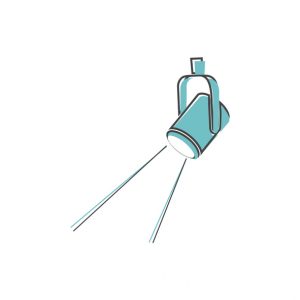ADHD Hyperfocus: How to manage this double-edged sword for your health and productivity
 Are you ever so engrossed in an activity that time seems to stop and nothing can tear you away? Does it ever seem like you lose sense of where you are and what’s happening around you? This can be the experience of hyperfocus for many people with ADHD. Hyperfocus is defined as “a phenomenon that reflects one’s complete absorption in a task, to a point where a person appears to completely ignore or ‘tune out’ everything else.” Hyperfocus frequently occurs during a fun or interesting activity, and it often crops up without conscious intent. Your concentration is captivated by something, and, although your attention can be channeled into have-to tasks, it can be drawn towards unproductive, procrastinating activities, too. That’s part of what makes it both exhilarating and frustrating.
Are you ever so engrossed in an activity that time seems to stop and nothing can tear you away? Does it ever seem like you lose sense of where you are and what’s happening around you? This can be the experience of hyperfocus for many people with ADHD. Hyperfocus is defined as “a phenomenon that reflects one’s complete absorption in a task, to a point where a person appears to completely ignore or ‘tune out’ everything else.” Hyperfocus frequently occurs during a fun or interesting activity, and it often crops up without conscious intent. Your concentration is captivated by something, and, although your attention can be channeled into have-to tasks, it can be drawn towards unproductive, procrastinating activities, too. That’s part of what makes it both exhilarating and frustrating.
Hyperfocus: A double-edged sword
Many people with ADHD see hyperfocus as a superpower: it’s a state of mind that fosters unusual productivity through total absorption in a task. But some folks also see it as a weakness: it accounts for vast periods of time spent on distractions to dodge unpleasant responsibilities. Hyperfocus, it seems, is a double-edged sword: a great capacity for effective performance on interesting, high-value tasks on the one side, and a great capacity for avoiding things by disappearing into pleasurable distractions on the other. By nurturing executive functioning skills such as prioritization, time management and self-awareness, you can harness the power of your hyperfocus more efficiently.
Self-Awareness During Hyperfocus
 Being aware of where you are directing your attention, and for how long, is an important step in addressing hyperfocus. Focus is a dynamic process of choosing what is critical to notice, attempt or recall. Where you direct your focus is akin to pointing the spotlight of your attention on something. Hyperfocus is an amplified type of focus, where you can be totally captivated on something until you are interrupted or just lose interest. Many folks with ADHD may not notice when the hyperfocus episode begins but become aware when they return from it. Perhaps this happens to you: you’re not sure where the time went, and you don’t really have a plan for re-entry or catching up. You can cope with these moments of disorientation by learning to be as intentional about what you’re not going to concentrate on as what you are going to do.
Being aware of where you are directing your attention, and for how long, is an important step in addressing hyperfocus. Focus is a dynamic process of choosing what is critical to notice, attempt or recall. Where you direct your focus is akin to pointing the spotlight of your attention on something. Hyperfocus is an amplified type of focus, where you can be totally captivated on something until you are interrupted or just lose interest. Many folks with ADHD may not notice when the hyperfocus episode begins but become aware when they return from it. Perhaps this happens to you: you’re not sure where the time went, and you don’t really have a plan for re-entry or catching up. You can cope with these moments of disorientation by learning to be as intentional about what you’re not going to concentrate on as what you are going to do.
Recognizing States of Focus and Distraction
To improve any type of focus, begin to notice where it is and where it isn’t. This is more difficult than it sounds, and, when somebody is stressed, anxious or depressed, it’s even tougher. Marla, a twenty year old sophomore in college who struggled with panic attacks, complained to me about her required writing course and her distractability: “It’s boring, I hate writing, and the teacher has a monotonous voice that puts me to sleep. I pay attention to any little thing except what’s going on and then, when he calls on me, I am totally lost and embarrassed.” I asked her to make a list of things that distracted her in that class and to bring it to my office for the next session. She reported that, just by noticing where her attention went, she was able to bring herself back to the class discussion more often, and even made a few relevant comments. Paying attention to where your attention goes is similarly effective in handling hyperfocus episodes.
The Unhealthy Costs of Hyperfocus
The experience of hyperfocus differs widely from person to person, because it vacillates from being a helpful tool for productivity and an effective way to escape. Self-care activities such as eating, drinking and using the bathroom may be postponed for hours, resulting in low blood sugar, irritability and fatigue. 
Kieran, age 25, says: “Hyperfocus is confusing. It’s the only time when I get to be more productive at work than anybody else. I can do more in three hours than my neurotypical colleagues get done in twice that time. But, at home, sometimes I zone out while gaming and forget to check my phone for texts or even go to sleep. Then, I’m exhausted the next day.”
Ellie, age 40, explains the value and challenges of hyperfocus: “Hyperfocus is the only time that I feel truly alive. My brain is fully engaged, 100%, time stops, and I’m flying along. But my partner or my co-workers have to poke me in the arm to remind me about lunch or a big meeting. At the end of a good day, with a lot accomplished, I can feel quite energized.”
Change Takes Practice
Although you may finish tasks, some aspects of hyperfocus do not foster healthy productivity. This can be challenging for kids, teens and adults who experience hyperfocus. However, tools for coping with hyperfocus and managing it more mindfully can improve with practice and experience. Michayla, age 33, has learned how to manage hyperfocus better as she has gotten older: “Hyperfocus is when I can do a single task without getting distracted and think only about it. But I also lose touch with my body and don’t notice that I’m hungry, thirsty or need to use the bathroom. As a child, I had so many bladder infections because I never stopped to go to the bathroom. On my home videos, I always have this little pink liquid and a straw with me. It’s an antibiotic. That’s how many bladder infections I had. Now, I stop to go to the bathroom, have a drink or eat something so I don’t get dizzy.”
Flow vs. Hyperfocus: Related, but not the same
 Everybody experiences flow states at one time or another that are triggered by internal motivation and external situations. These flow states–often called ‘being in the zone,’ refer to heightened intuition and performance, where decisions happen automatically and creative breakthroughs occur. They are positive, desirable and can be cultivated and planned for. Hyperfocus, on the other hand, is typically experienced by people with ADHD and stems from challenges with handling the direction of focus and the depth of attention. Hyperfocus is more unpredictable, it appears intermittently, and it’s usefulness varies. When hyperfocus is helpful, it’s usually because somebody has entered into a temporary flow state. If you can identify the difference between your personal states of flow and hyperfocus, you’re more likely to optimize your productivity.
Everybody experiences flow states at one time or another that are triggered by internal motivation and external situations. These flow states–often called ‘being in the zone,’ refer to heightened intuition and performance, where decisions happen automatically and creative breakthroughs occur. They are positive, desirable and can be cultivated and planned for. Hyperfocus, on the other hand, is typically experienced by people with ADHD and stems from challenges with handling the direction of focus and the depth of attention. Hyperfocus is more unpredictable, it appears intermittently, and it’s usefulness varies. When hyperfocus is helpful, it’s usually because somebody has entered into a temporary flow state. If you can identify the difference between your personal states of flow and hyperfocus, you’re more likely to optimize your productivity.
4 Tips to Help Adults Better Manage Their Hyperfocus:
1. Identify and investigate:
Learn more about your pattern of hyperfocus by increasing self-awareness.
-
- What does hyperfocus look like for you?
- How long does it occur?
- Do you neglect self-care?
- How do you respond to interruptions?
Notice when you tend to engage in hyperfocus by examining the situation, the environment and your motivation. Are you focusing on an interesting task or avoiding something unappealing? This type of reflection will increase your capacity for metacognition, helping you monitor when hyperfocus takes over. Thoughtful self-evaluation will also help you take action to exit from an episode.
2. Plan and prioritize:
 Do a brain dump of all of the tasks in front of you for the day or the week. Then, make another, shorter list where you order the tasks in terms of urgency (do it now because of a deadline) or importance (value and satisfaction with less pressure). Then, break down your day into blocks of time, and assign the urgent tasks first, followed by the important ones. Limit the quantity of the tasks into each block of time so you can reach your goals and feel accomplishment. You can limit the number of tasks by flagging the ones that can be rolled over into tomorrow.
Do a brain dump of all of the tasks in front of you for the day or the week. Then, make another, shorter list where you order the tasks in terms of urgency (do it now because of a deadline) or importance (value and satisfaction with less pressure). Then, break down your day into blocks of time, and assign the urgent tasks first, followed by the important ones. Limit the quantity of the tasks into each block of time so you can reach your goals and feel accomplishment. You can limit the number of tasks by flagging the ones that can be rolled over into tomorrow.
3. Improve time management practices:
Use tools to increase your awareness of time and how it passes. Set up several alerts, using a variety of tools–your phone, your computer, banners across the screen, analog clocks or timers. Work in intervals with planned, structured breaks to keep yourself on track and limit the negative aspects of hyperfocus.
4. Find an accountability buddy:
You don’t have to address the challenging, over-absorbing aspects of hyperfocus alone! Instead, ask someone in your life to check in with you at times when you are prone to hyperfocus. It could be a family member, friend, colleague, or someone you met at an ADHD support group. This can help you break up these hyperfocus periods. If this person also has ADHD, you can support each other with this practice. Helping somebody else with their hyperfocus can assist you with your own focus regulation as well. 
Read more blog posts:
- Recognizing Inattentive ADHD: The 5 Most Overlooked Signs and Helpful Tips for Living with Them
- ADHD and Metacognition: Learning to reflect on your thoughts and experiences with a growth mindset
- Planning and Prioritizing Practices for ADHD Brains: What’s the plan, and when do you start?!
Watch on Dr. Saline’s YouTube Channel:
- The Pros and Cons of Hyperfocus (ADHD Support Group / Q&A)
- ADHD and Metacognition – Executive Functioning Support (ADHD Support Group / Q&A)
